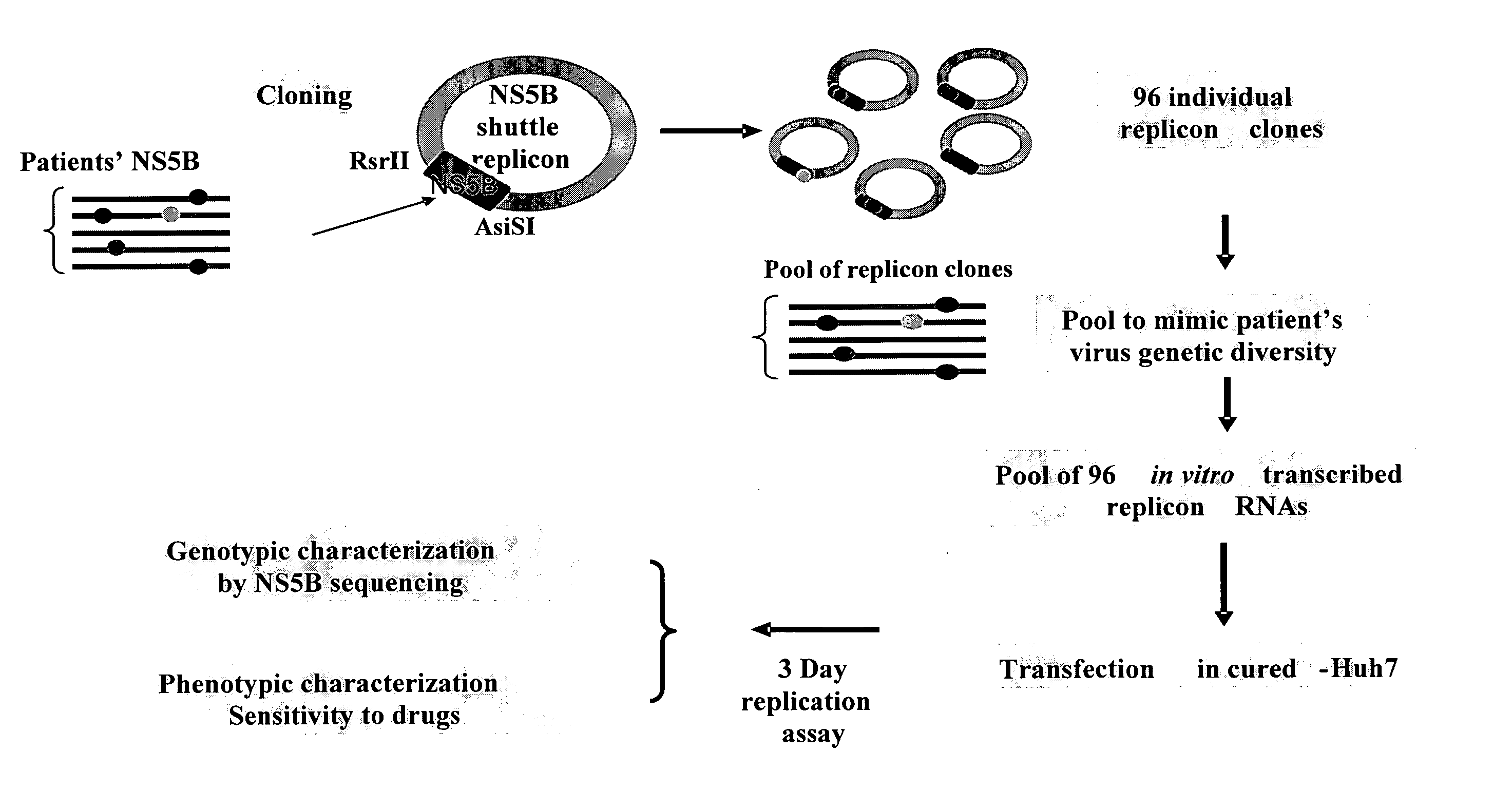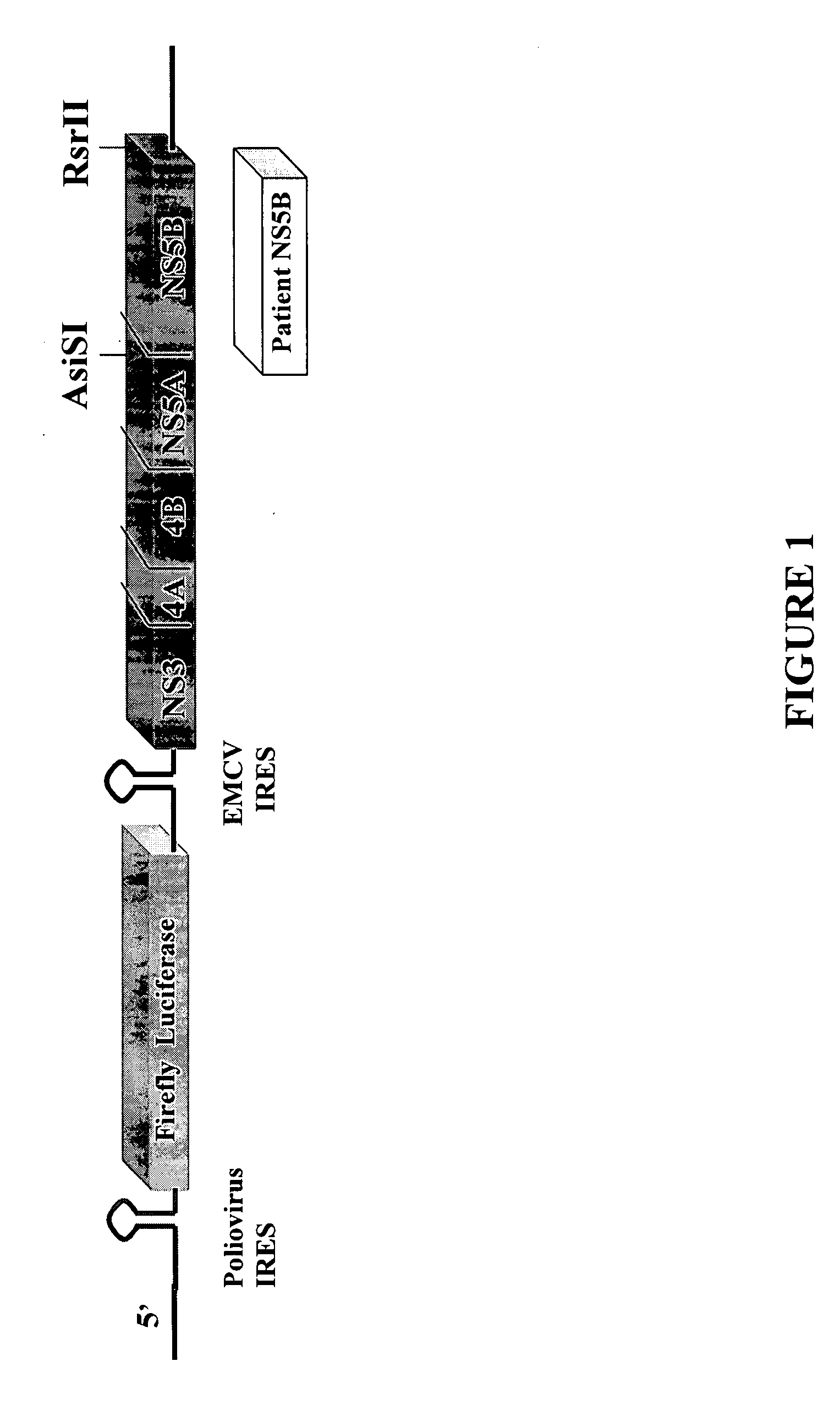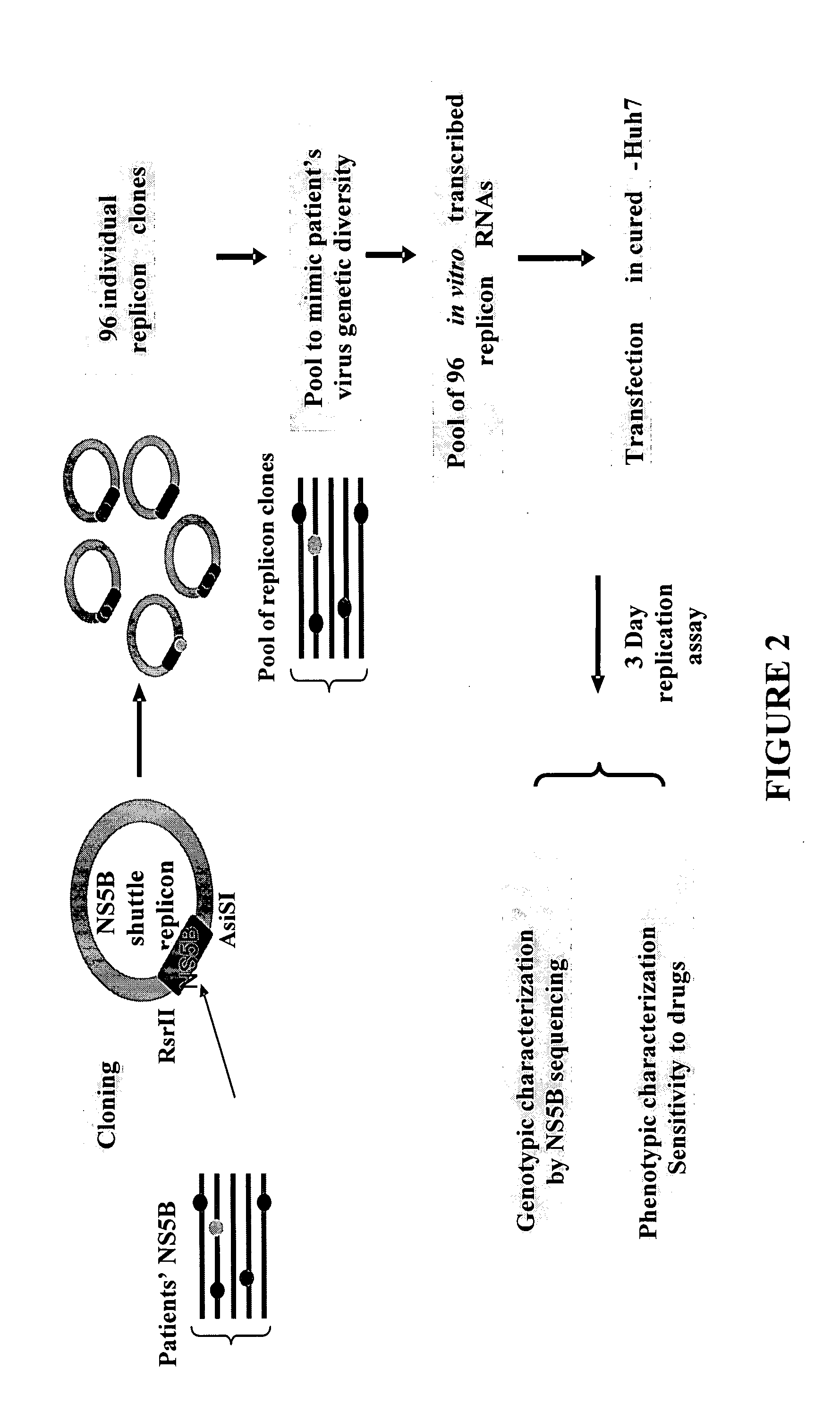HCV replicon shuttle vectors
a shuttle vector and hcv technology, applied in the field of hcv replicon shuttle vectors, can solve the problems of limited clinical benefit, low level of hcv replication, and inability to perform detailed analysis, etc., to achieve high error rate, sensitivity or resistance of these variants, and reproducibility. and susceptibility, the effect of high error ra
- Summary
- Abstract
- Description
- Claims
- Application Information
AI Technical Summary
Benefits of technology
Problems solved by technology
Method used
Image
Examples
example 1
Construction of Plasmids
[0046] The transient HCV genotype-1b Con1 replicon vector rep PI-luc / ET, shown in FIG. 1, was obtained from R. Bartenschlager and contains the HCV polynucleotide sequence from the 5′-UTR, NS3 through NS5B proteins and the 3′-UTR disclosed in GenBank Accession Number AJ238799. It also includes the polio virus internal ribosome entry site (IRES), which controls the translation of a firefly luciferase gene. Downstream of the firefly luciferase gene, the IRES from the encephalomyocarditis virus (EMCV) controls the translation of the HCV non-structural genes (NS3, NS4A, NS4B, NS5A and NS5B).
[0047] The transient replicon repPI-luc / ET vector was modified to replace the pBR322 backbone with the pUC18 backbone to generate replicon pPI-luc / ET / SC (SEQ ID NO:1). In test assays, pPI-luc / ET / SC replicated with similar levels to rep PI-luc / ET (see Table 1).
[0048] The transient HCV genotype-1a H77 replicon vector pSS-1 was generated by ligating a SpeI-BsrGI fragment from ...
example 2
Cloning of the NS5B PCR Samples Amplified from Infected Patients into pSC—1b_NS5B—5′AsiSI—3′SacII and pSC—1b_delNS5B—5′AsiSI—3′SacII
[0054]FIG. 2 provides a graphical representation of the experimental design of the cloning of the patient-derived NS5B PCR samples into the replicon shuttle vector and the testing of the resulting replicons. Briefly, DNA sequences encoding the NS5B protein were PCR-generated either directly from plasma or from DNA amplified from plasma obtained from patients infected with HCV using either degenerate primers or patient specific primers wherein the sense-strand primers contain an AsiSI restriction site sequence and the antisense-strand primers contain a SacII restriction site sequence.
[0055] Sense-strand AsiSI primers used include:
(SEQ ID NO:9)5′-GGAGGCTAGTGAGGACGCGATCGCTTGCTCAATGTCGTA-3′(SEQ ID NO:10)5′-GGAGGCTAGTGAGGACGCGATCGCTTGCTCAATGTCTTA-3′(SEQ ID NO:11)5′-GGAGGCTAGTGAGGACGCGATCGCTTGCTCRATGTCCTA-3′(SEQ ID NO:12)5′-GGAGGCTAGTGAGGACGCGATCGCCTGCTC...
example 3
Cloning of the NS5B PCR Samples Amplified from Infected Patients into pSC—1b_NS5B—5′AsiSI—3′RsrII, pSC—1b—5′AsiSI_lacZAmC—3′RsrII, pSS-1—1a_NS5B—5′AsiSI—3′RsrII, and pSS-1a—5′AsiSI_lacZAmC—3′RsrII
[0062] Cloning of NS5B PCR samples into the vectors which contain RsrII at the 3′ end of the NS5B gene were conducted using the procedures described in Example 2 except that the following antisense-strand primers containing RsrII restriction site were used for PCR-amplifying patient NS5B:
(SEQ ID NO:25)5′-GGCCTGGAGTGTTTAGCTCGGACCGTCATCGRTTGGGGAG-3′(SEQ ID NO:26)5′-GGCCTGGAGTGTTAGCTCGGACCGTCACCGGTTGGGGAG-3′(SEQ ID NO:27)5′-GGCCTGGAGTGTTTAGCTCGGACCGTCAYCGGTTGGGGAG-3′(SEQ ID NO:28)5′-GGCCTGGAGTGTTTAGCTCGGAGCGTCATCGGTTGGGAAG-3′(SEQ ID NO:29)5′-GGCCTGGAGTGTTTAGCTCGGACCGTCAACGGTTGGGAAG-3′(SEQ ID NO:30)5′-GGCCTGGAGTGTTTAGCTCGGACCGTCAACGGTTTGGGGTA-3′(SEQ ID NO:31)5′-GGCCTGGAGTGTTTAGCTCGGACCGTCATCGGTTGGGRAG-3′(SEQ ID NO:32)5′-GGCCTGGAGTGTTTAGCTCGGACCGTCATCGGTTGGGGTA-3′(SEQ ID NO:33)5′-GGCCTGGAGTG...
PUM
| Property | Measurement | Unit |
|---|---|---|
| Time | aaaaa | aaaaa |
Abstract
Description
Claims
Application Information
 Login to View More
Login to View More - R&D
- Intellectual Property
- Life Sciences
- Materials
- Tech Scout
- Unparalleled Data Quality
- Higher Quality Content
- 60% Fewer Hallucinations
Browse by: Latest US Patents, China's latest patents, Technical Efficacy Thesaurus, Application Domain, Technology Topic, Popular Technical Reports.
© 2025 PatSnap. All rights reserved.Legal|Privacy policy|Modern Slavery Act Transparency Statement|Sitemap|About US| Contact US: help@patsnap.com



